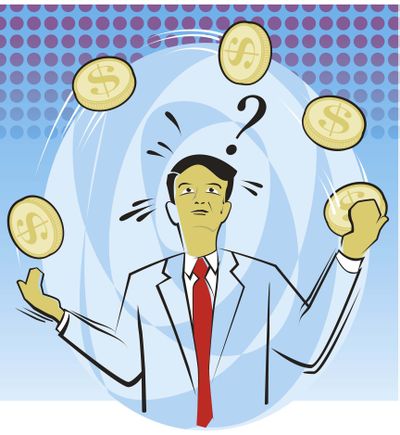Put your financial fundamentals to the test

When it comes to understanding money, Washington’s high school students are earning a failing grade.
High school seniors could answer just 48 percent of the questions on a 2008 survey about financial matters conducted by the JumpStart Coalition, a group that advocates financial literacy education. And yet many adults also struggle to understand concepts that are routine parts of their financial lives. Only 18 percent of baby boomers surveyed in 2006 could calculate a 10 percent interest rate over two years.
Can you do any better?
Here is a quiz compiled from questions on the JumpStart survey, a Better Business Bureau questionnaire, and elsewhere. The answers are at the end. (A majority of high school seniors in Washington got questions 1-7 wrong).
1 Many people put aside money to cover unexpected expenses. If Juan and Elva have money put aside for emergencies, in which of the following forms would it be of LEAST benefit to them if they needed it right away?
A) Invested in a down payment on a house.
B) Checking account.
C) Stocks.
D) Savings account.
2 If your credit card is stolen and the thief runs up a debt of $1,000, but you notify the issuer of the card as soon as you discover it is missing, what is the maximum amount you can be forced to pay, according to federal law?
A) $500.
B) $1,000.
C) Nothing.
D) $50.
3 Scott and Eric are young men. Each has a good credit history. They work at the same company and make approximately the same salary. Scott has borrowed $6,000 to take a foreign vacation. Eric has borrowed $6,000 to buy a car. Who is likely to pay the lower finance charge?
A) Eric will pay less because the car is collateral for the loan.
B) They will pay the same because the rate is set by law.
C) Scott will pay less because people who travel overseas are better risks.
D) They will pay the same because they have almost identical financial backgrounds.
4 Many savings programs are protected by the federal government against loss. Which of the following is not?
A) A U.S. savings bond.
B) A certificate of deposit at the bank.
C) A bond issued by one of the 50 states.
D) A U.S. Treasury bond.
5 Which of the following credit-card users is likely to pay the greatest dollar amount in finance charges per year, if they all charge the same amount per year on their cards?
A) Jessica, who pays at least the minimum amount each month and more when she has the money.
B) Vera, who generally pays off her credit card in full but occasionally will pay the minimum when she’s short of cash.
C) Megan, who always pays off her credit card bill in full shortly after she receives it.
D) Erin, who only pays the minimum amount each month.
6 Who insures your stocks in the stock market?
A) The Federal Deposit Insurance Corporation.
B) The Securities and Exchange Commission.
C) The U.S. Department of the Treasury.
D) No one.
7 How many days does a creditor have to acknowledge your written complaint about a billing error?
A) 30 days.
B) 60 days.
C) 90 days.
D) 120 days.
8 Negative financial information can stay on your credit report for how long?
A) 2 years.
B) 5 years.
C) 7 years.
D) 10 years.
9 Let’s say you have $200 in a savings account. The account earns 10 percent interest per year. How much would you have in the account at the end of two years?
A) $220.
B) $222.
C) $242.
D) $240.
10 If you charge a $2,100 laptop computer to your credit card, which has an interest rate of 19 percent on purchases, and you only make the minimum payments (4 percent of the balance), what will the total cost of your laptop be, and when will it be paid off? (This is assuming you don’t have any other charges on your credit card.)
A) $2,573.24; 2 years and 2 months.
B) $3,382.87; 10 years.
C) $5,274.66; 20 years and 4 months.
D) $8,678.65; 37 years.
11 A consumer takes out a payday loan for $100 that has a $15 fee. At the end of 2 weeks, the consumer pays back the full $115. What was the annual percentage rate (APR) charged on this loan?
A) 15 percent.
B) 115 percent.
C) 255 percent.
D) 390 percent.
Answers: 1) A; 2) D; 3) A; 4) C; 5) D; 6) D; 7) A; 8) D; 9) C; 10) B; 11) D